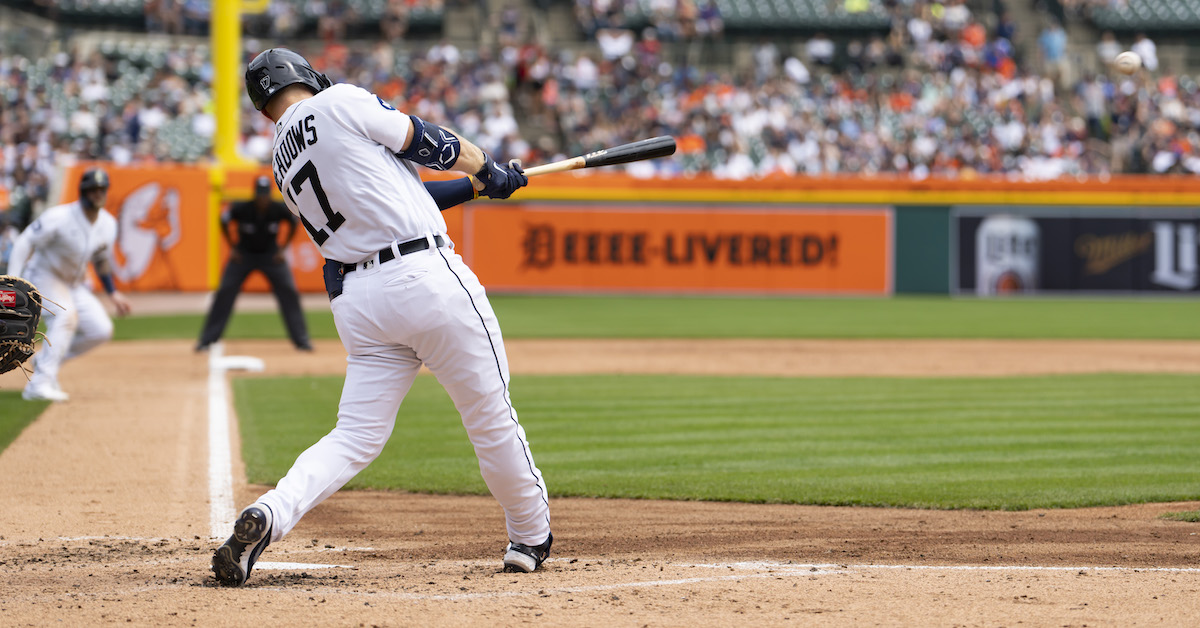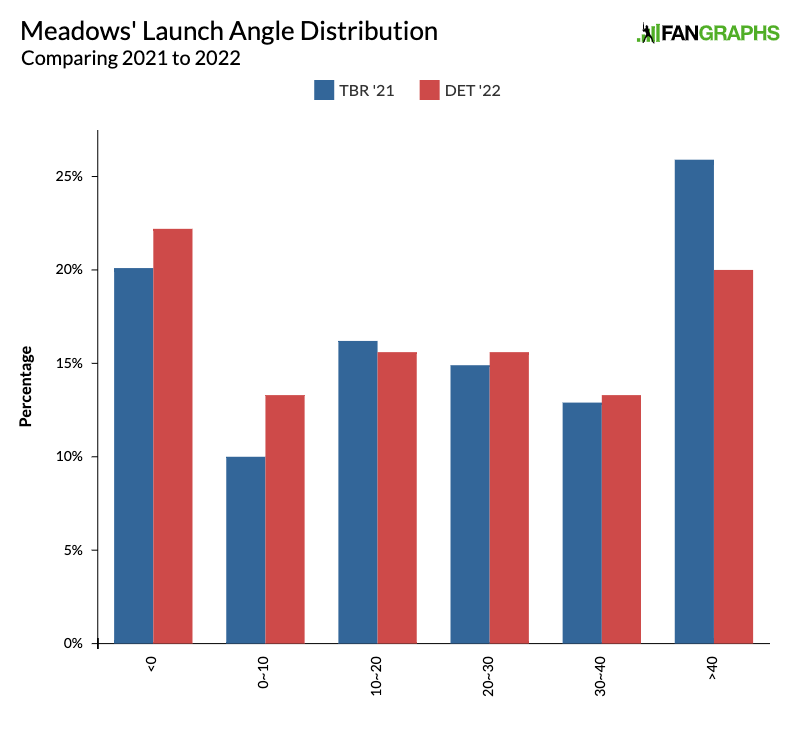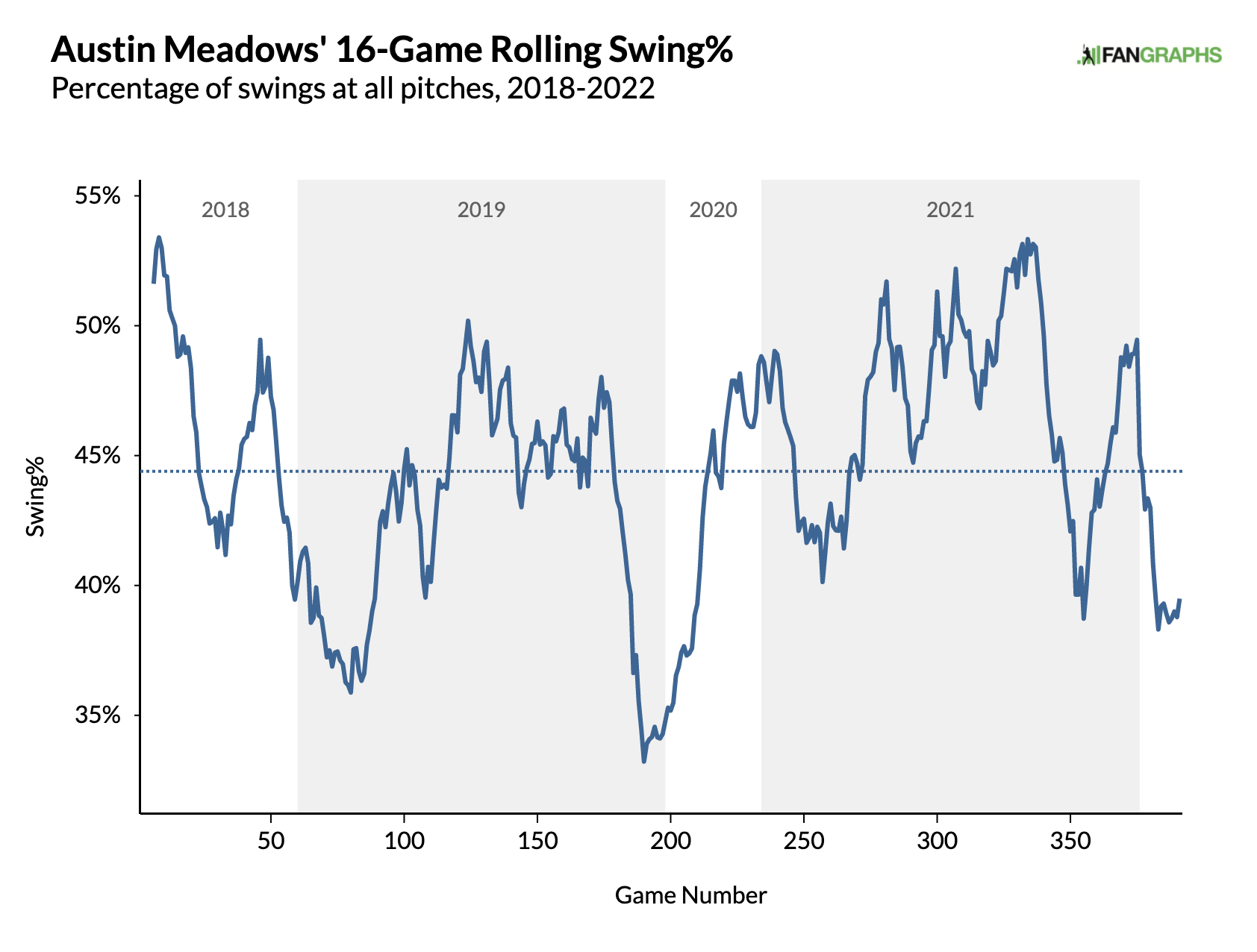This Year’s Austin Meadows in Three Parts

Mike Trout is climbing up the WAR leaderboards; nature is healing. Still, it’s probably best to remember that we’re in the season’s early going. Eric Hosmer is batting .415! Meanwhile, Yuli Gurriel is batting .203. Some players have been unbelievably hot, others have been mysteriously cold — these extremes tend to balance out by season’s end. Players usually remain who they are, despite the memorable breakouts.
That principle also extends to changes in a player’s approach, pitch mix, or swing mechanics. Often, those eager to better themselves will start the season with a completely different look. Reality tends to get in the way, though. Sometimes injuries happen, or old habits prove hard to shake. Many players won’t see their changes through a year’s worth of trouble. It’s just the nature of things.
With that in mind, let’s talk about Austin Meadows. He’s a Detroit Tiger now, having arrived from St. Petersburg in a trade only his former team would dare to orchestrate. And he’s off to a pretty good start, with his .304/.418/.411 line translating to a 154 wRC+ in an offensively challenged season. It’s not so surprising, since Meadows has proven himself many times to be a great hitter. What is worth noting is how he’s arrived at that mark. In a few ways, Meadows looks like a different hitter than the one he was a year or two ago. So if you’re willing, I’d like to highlight some interesting (warning: subjective) things that have defined his productive April. I’ll present them in three parts.
Part One
This one is quite simple. Through Thursday’s games, Meadows’ whiff rate ranks in the 94th percentile. Last year, it ranked in the 54th percentile, and the year before that, the 21st percentile. Meadows broke out in 2019 with an ideal marriage of contact quality and bat to ball skills, but the second part of that equation fell apart in subsequent years. He’s on a quest to quell the swings and misses, with his encouraging start to 2022 continuing a gradual climb towards that goal:

More contact doesn’t guarantee anything about what happens once a ball is put in play, but it does ensure that a hitter isn’t wasting outs. Just 14.9% of Meadows’ plate appearances have ended in an unproductive strikeout this season, a rate that places him ahead of names like Freddie Freeman and Starling Marte. The future probability of that aside, it’s a sign of Meadows refining a crucial aspect of his game. Considering what lies ahead in this article, that’s scary to think about.
Part Two
You might have noticed that the shape of Meadows’ early production is a bit… odd. He’s definitely not a hitter you’d expect to have a slugging percentage that’s lower than his on-base percentage. In more obvious terms, he’s yet to hit a home run in 67 plate appearances. Is there anything concerning about his power we should be paying attention to?
Not much, thankfully. His batted ball metrics are largely unchanged, and Meadows is still hitting a healthy rate of fly balls. Calling Comerica Park home doesn’t help his cause, but the long ball should return. That said, I did notice a slight departure from last year. I’m not sure whether this is necessarily a good or a bad thing, but it’s there nonetheless, and it seems noteworthy enough to elaborate on. Meadows has an uppercut swing. That helps him generate loft, but as a downside, it also means he pops the ball up a fair amount of the time. A popup is basically a glorified strikeout – it doesn’t make the hitter look as bad, sure, but it’s an automatic out 99 times out of 100. Meadows has trimmed down the first type of automatic out, so it’s even better that the second, less-discussed type is down as well:

Baseball Savant uses a more stringent definition for popups, but there’s a reason why I chose the 40-degree threshold: Since the start of the Statcast era, only 0.5% of all batted balls above 40 degrees have ended up as home runs. The rest are either lazy fly outs or fluke hits, meaning hitters aren’t really getting much of out them. And so far, that’s the area Meadows has avoided the best relative to last season. Now, about this maybe not being a slam-dunk improvement: It seems like those fly balls are ending up as grounders instead, which aren’t too valuable themselves. What’s arguably more important, though, is that Meadows isn’t doing this at the expense of line drives. The extremes have fluctuated, but that 10 to 30 degree range is secure.
For what it’s worth, I combed through the videos but didn’t notice any alterations to his swing. Plus, that 2022 distribution is based on sample of 46 batted balls, so it’s not the most robust. Take it with as many grains of salt as you’d like. ‘Tis the time for speculation, though, and a genuine increase in launch angle consistency and tightness would do wonders for Meadows. At this point, we’ve considered his bat-to-ball skills and his contact quality. That leaves us with one last component…
Part Three
At first, this also seems straightforward. Below is a graph of Meadows’ swing rate by season:

Alright! Meadows is swinging at a career-low frequency. That’s cool. He has always possessed a keen eye, but it’s become sharper as a consequence of his newfound patience: His chase rate so far this season is 21.8%, down significantly from the 26.5% mark he recorded last season. That also means he’s going after fewer pitches inside the zone, but that’s a trade-off almost every hitter makes – unless your name is Juan Soto, of course, in which case the principles of game theory are largely irrelevant to you.
But this is hardly a responsible way to look at what Meadows has accomplished. It’s a bit disingenuous to compare a 16-game stretch to full-length seasons. Instead, a more appropriate examination involves breaking down Meadows’ entire career into 16-game chunks. Does this decrease in swing rate have a precedent? Actually, yes:

Other than the dip corresponding to this month, we can spot three additional local minima. The first, which covers April 2019, saw Meadows’ swing rate dip as low as 35.9%. The second, which covers September of that same year, saw him basically refusing to swing, and appears all the more dramatic juxtaposed against a relatively tame August. The third occurred late last year and resembles what’s happening now. So Meadows isn’t exactly in uncharted territory. At the same time, though, he very much is. Here’s his swing rate by pitch category, either fastballs or breaking balls, in each low-swing month of Meadows’ young career:
| Month | Fastball Swing% | Breaking Swing% | F-B Swing% |
|---|---|---|---|
| April 2019 | 42.0% | 41.9% | -0.1% |
| September 2019 | 48.0% | 41.7% | -6.3% |
| August 2021 | 45.9% | 38.9% | -7.0% |
| April 2022 | 44.4% | 29.8% | -14.6% |
This, I think, is what distinguishes this recent development from a mere semi-annual blip. Meadows is essentially exhibiting the same old tendencies against fastballs, while exploring the limits of his discipline against breaking balls. Before, this sort of distinction didn’t really exist. It’s not as if Meadows has been terrible against breaking balls throughout his career, but like most hitters, a large portion of his production stemmed from ambushing the hard stuff. He’s ignoring pitches that are trickier to square up, perhaps allowing him to focus on timing those fastballs. He isn’t giving up on hittable pitches – if anything, the opposite has been true so far.
It goes without saying this might all end up not mattering. The 2022 sample is still minuscule; we’re still on the edges of April, patiently waiting for the noise to die down. But I’m excited about Meadows nonetheless. His early-season showing is noteworthy in particular because of its multi-faceted nature. While maintaining what made him an effective slugger to begin with, he’s sprinkled in minor adjustments that all point towards a more sustainable and nuanced approach. We might just be throwing darts in the dark at this point in the season, but this one seems like it could end up being on target.
Justin is an undergraduate student at Washington University in St. Louis studying statistics and writing.

Choi, another swing and another XBH. Interesting article, good spin, well-executed. Keep up the great work.